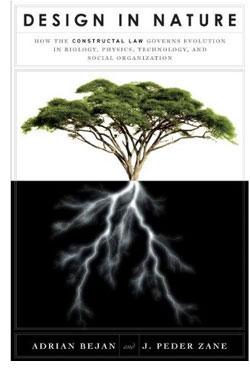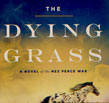 |
 |
 Adrian Bejan and J. Peder Zane
Adrian Bejan and J. Peder Zane
Design in Nature: How the Constructal Law Governs Evolution in Biology, Physics, Technology, and Social Organization
Doubleday / Random House
US Hardcover First Edition
ISBN 978-0-385-53461-1
Publication Date: 01-24-2012
296 Pages; $27.95
Date Reviewed: 02-18-2012
Reviewed by: Rick Kleffel © 2012
Index:
Non-Fiction
We often hear about scientific revolutions, but the word revolution is really is misnomer. It implies the swift overthrow of one belief for another. Science does not discard beliefs overnight. It's a measured process, especially now, in an age where so much technology can be brought to examine, evaluate and even discover new data. But discoveries can be made, even basic discoveries.
At least, that is the contention of Adrian Bejan, whose 'Design in Nature: How the Constructal Law Governs Evolution in Biology, Physics, Technology, and Social Organization' offers a popular-science exposition of a new law of physics. It's both low-key and a grand claim. Bejan discovered his new law of physics some fifteen years ago. He's published it in textbooks and peer-reviewed journals since then. Of course, whether or not this proves to be a basic, universal law of physics is a matter of decades, perhaps centuries. But as a book, 'Design in Nature' passes one key test. Read this and you'll see everything differently.
Bejan frames his book as the story of his discovery, giving it a narrative through-line. He's a mechanical engineer who had been working on a heat sink for computer chips, and found that the best means of doing so involved a series of branching lines, like a tree. While attending a conference on thermodynamics, he heard Nobel Laureate Ilya Prigogine assert that the similarity between tree-shaped structures in nature was cosmic coincidence. Having just designed a tree-shaped structure to enhance the flow of heat away from a computer chip, Bejan knew that this was not the case. While flying back from the conference, he wrote down the constructal law: "For a finite-size system to persist in time (to live), its configuration must evolve in such a way that provides easier access to the currents that flow through it." Having formulated the law, Began to put it to use to predict outcomes, found that it worked, and he's been going with the flow ever since.
Bejan, and his co-author, J. Peder Zane take the reader on an outward journey, through the various branches of science exploring the consequences of the constructal law in geology and geography, biology and physiology, evolution, and even into sports, academia and the social and political realms. Once you start reading this book, prepare to start seeing trees everywhere you look. The authors are careful to be sure that readers understand that this is not an argument for a "designer." 'Design in Nature' is NOT, repeat, not a stalking horse for intelligent design or creationism. This is a new law of physics that requires no supernatural intervention, and is based on evidence and the ability to predict new data.
The writing is generally informal and informative, but often buttressed by fairly sophisticated math. If you know and care, it's there, but if you don't you can still follow the logic of the authors' thoughts. As 'Design in Nature,' progresses, the applications become increasingly unexpected. But Bejan and Zane are careful to point out the data and hard science that backs up the applications.
'Design in Nature' is pretty powerful book, and it should be. The presentation of a new law of physics to a lay public has to argue in a court of opinion that is wider and less reasonable than that of pure science. Scientists can and always will base their judgments on facts and numbers and experimental evidence. The lay public makes its decisions as much from the heart as from the head. In that presentation, a book like 'Design in Nature' has a lot of weight to carry. Bejan and Zane are equal to the load. It won't happen overnight. The belief will grow slowly and branch outward. The best argument for the constructal law is the fact that it will predict its own acceptance, in science and society.
|
 |
|
|
 |
| |
Review Archive
All Reviews alphabetized by author.
General Fiction
Non-Genre, general fiction and literature.
Horror
Supernatural fiction, supernatural horror and non-supernatural horror.
Science Fiction
Science fiction, science fantasy, speculative fiction, alternate history.
Fantasy
Fantasy, surrealism and magic realism.
Mystery
Crime, thrillers, mystery, suspense.
Non-Fiction
Non-Fiction, True Crime, Forteana, Reference.
Poetry
|
|
 |
|




